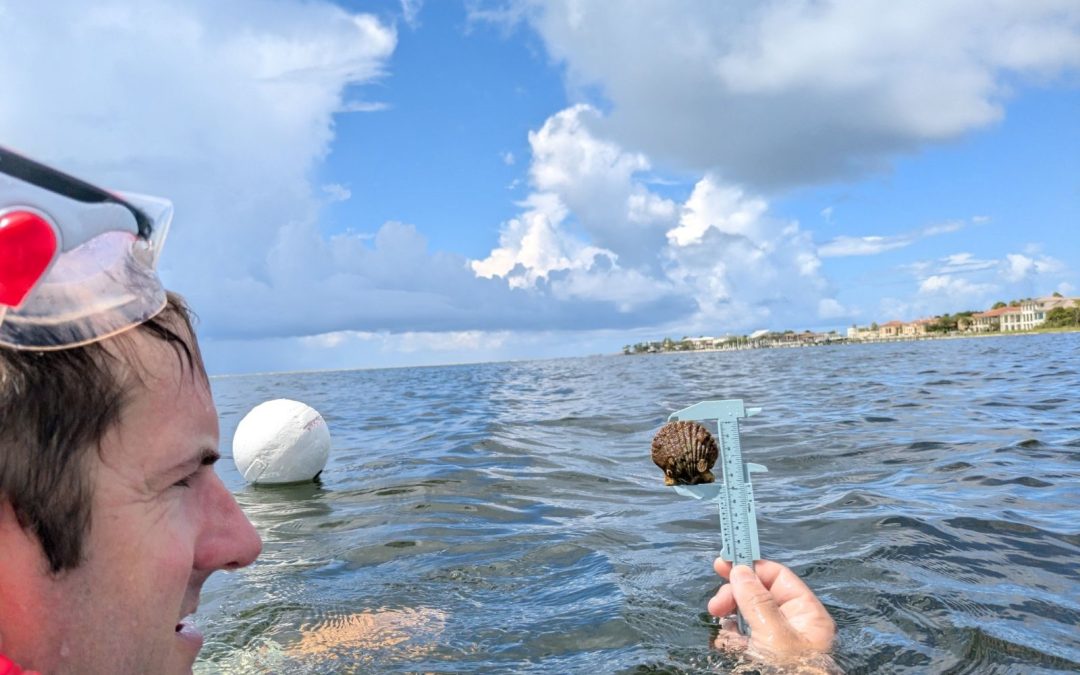
by Rick O'Connor | Sep 15, 2025
Introduction
The bay scallop (Argopecten irradians) was once common in the lower portions of the Pensacola Bay system. However, by 1970 they were all but gone. Closely associated with seagrass, especially turtle grass (Thalassia testudinum), some suggested the decline was connected to the decline of seagrass beds in this part of the bay. Decline in water quality and overharvesting by humans may have also been a contributor. It was most likely a combination of these factors.
Scalloping is a popular activity in our state. It can be done with a simple mask and snorkel, in relatively shallow water, and is very family friendly. The decline witnessed in the lower Pensacola Bay system was witnessed in other estuaries along Florida’s Gulf coast. Today commercial harvest is banned, and recreational harvest is restricted to specific months and to the Big Bend region of the state. With the improvements in water quality and natural seagrass restoration, it is hoped that the bay scallop may return to lower Pensacola Bay.
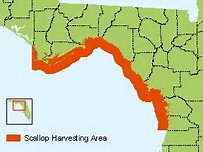
Scallop harvest area.
Image: Florida Department of Environmental Protection
Since 2015 Florida Sea Grant has held the annual Pensacola Bay Scallop Search. Trained volunteers survey pre-determined grids within Big Lagoon and Santa Rosa Sound. Below is the report for both the 2025 survey and the overall results since 2015.
Methods
Scallop searchers are volunteers trained by Florida Sea Grant. Teams are made up of at least three members. Two snorkel while one is the data recorder. More than three can be on a team. Some pre-determined grids require a boat to access, others can be reached by paddle craft or on foot.
Once on site the volunteers extend a 50-meter transect line that is weighted on each end. Also attached is a white buoy to mark the end of the line. The two snorkelers survey the length of the transect, one on each side, using a 1-meter PVC pipe to determine where the area of the transect ends. This transect thus covers 100m2. The surveyors record the number of live scallops they find within this area, measure the height of the first five found in millimeters using a small caliper, which species of seagrass are within the transect, the percent coverage of the seagrass, whether macroalgae are present or not, and any other notes of interest – such as the presence of scallop shells or scallop predators (such as conchs and blue crabs). Three more transects are conducted within the grid before returning.
The Pensacola Scallop Search occurs during the month of July.
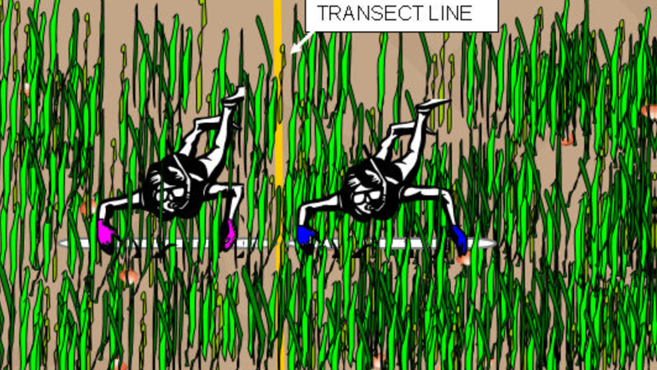
Snorkel transect method.
Image: University of Florida.
2025 Results
138 volunteers on 32 teams surveyed 22 of the 66 1-nautical mile grids (36%) between Big Lagoon State Park and Navarre Beach. 162 transects (16,200m2) were surveyed logging 8 scallops. All live scallops were reported from Santa Rosa Sound this year.
2025 Big Lagoon Results
13 teams surveyed 9 of the 11 grids (81%) within Big Lagoon. 76 transects were conducted covering 7,600m2.

No scallops were logged in 2025 though scallop shells were found. No sea urchins were reported but scallop predators – such as conchs, blue crabs, and rays were. This equates to 0.00 scallops/200m2 and moves Big Lagoon from a vulnerable system last year to a collapsed one this year. All three species of seagrass were found (Thalassia, Halodule, and Syringodium). Seagrass densities ranged from 50-100%. Macroalgae was present in 5 of the 9 grids (56%) and was reported abundant in grid 2.
2025 Santa Rosa Sound Results
19 teams surveyed 13 of the 55 grids (23%) in Santa Rosa Sound. 86 transects were conducted, covering 8,600m2.
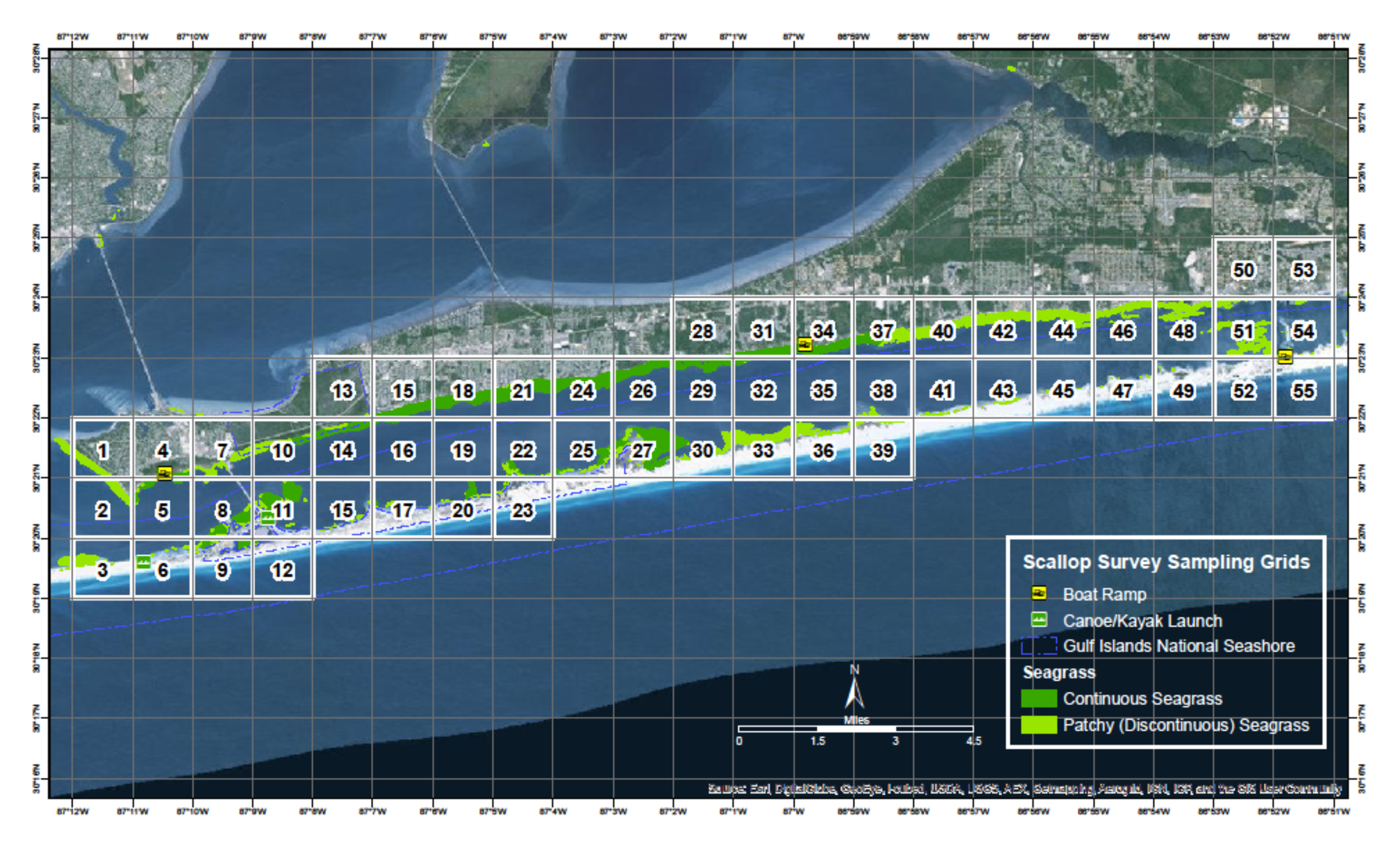
8 scallops were logged which equates to 0.19 scallops/200m2. Scallop searchers reported blue crabs, conchs, and rays. All three species of seagrass were found. Seagrass densities ranged from 5-100%. Macroalgae was present in 7 of the 13 grids (54%) and was reported as abundant in 4 of those.
2015 – 2025 Big Lagoon Results
| Year |
No. of Transects |
No. of Scallops |
Scallops/200m2 |
| 2015 |
33 |
0 |
0.00 |
| 2016 |
47 |
0 |
0.00 |
| 2017 |
16 |
0 |
0.00 |
| 2018 |
28 |
0 |
0.00 |
| 2019 |
17 |
0 |
0.00 |
| 2020 |
16 |
1 |
0.12 |
| 2021 |
18 |
0 |
0.00 |
| 2022 |
38 |
0 |
0.00 |
| 2023 |
43 |
2 |
0.09 |
| 2024 |
67 |
101 |
3.02 |
| 2025 |
76 |
0 |
0.00 |
| Big Lagoon Overall |
399 |
104 |
0.52 |
2015 – 2025 Santa Rosa Sound Results
| Year |
No. of Transects |
No. of Scallops |
Scallops/200m2 |
| 2015 |
01 |
0 |
0.00 |
| 2016 |
01 |
0 |
0.00 |
| 2017 |
01 |
0 |
0.00 |
| 2018 |
01 |
0 |
0.00 |
| 2019 |
01 |
0 |
0.00 |
| 2020 |
01 |
0 |
0.00 |
| 2021 |
20 |
0 |
0.00 |
| 2022 |
40 |
2 |
0.11 |
| 2023 |
28 |
2 |
0.14 |
| 2024 |
85 |
32 |
0.76 |
| 2025 |
86 |
8 |
0.19 |
| Santa Rosa Sound Overall |
2591 |
44 |
0.34 |
1 Transects were conducted during these years but data for Santa Rosa Sound was logged by an intern with the Santa Rosa County Extension Office and is currently unavailable.
Discussion
Based on a Florida Fish and Wildlife Research Institute publication in 2018, the final criteria are used to classify scallop populations in Florida.
| Scallop Population / 200m2 |
Classification |
| 0-2 |
Collapsed |
| 2-20 |
Vulnerable |
| 20-200 |
Stable |
Based on this, over the last nine years we have surveyed, the populations in lower Pensacola Bay are still collapsed. Big Lagoon reached the vulnerable level in 2024, but no scallops were found there in 2025, returning to a collapsed state.
There are some possible explanations for low numbers in 2025.
- It has been reported by some shellfish biologists that bay scallops have a “boom-bust” cycle. Meaning that one year their populations “boom” before returning to normal numbers. We could have witnessed this between 2024 and 2025.
- Though we did not monitor water temperatures, July 2025 was extremely hot, and many volunteers reported their sites felt like “bath water”. Collecting efforts on other projects during July reported not capturing anything – no pinfish, hermit crabs – their nets were empty. It is possible that these warm conditions could have caused many organisms to move to deeper/cooler depths. Note here; as the project moved into August temperatures did begin to cool and searchers began reporting fish, conchs, blue crabs, and rays.
The Pensacola Bay area continues to have a collapsed system. The larger populations found in 2024 suggest that there are scallops in the area but may not be enough to increase their population status from collapsed to vulnerable. We will continue to monitor each July.
It is important for locals NOT to harvest scallops from either body of water. First, it is illegal. Second, any chance of recovering this lost population will be lost if the adult population densities are not high enough for reproductive success.
Acknowledgements
We would like to thank ALL 138 volunteers who surveyed this year. We obviously could not have done this without you.
Below are the “team captains”.
Ethan Sadowski John Imhof Kaden Luttermoser
John Wooten Susan Pinard Matt MacGregor
Christian Wagley Sean Hickey Jason Buck
Brian Mitchell Angela Guttman Caitlen Murrell
Samantha Brady (USM) Michelle Noa Kira Benton
Monica Hines Wesley Allen Kelly Krueger
Mikala Drees Jonathan Borowski Michael Currey
Gina Hertz Melinda Thoms Beau Vignes
Bill Garner Robert Moreland Stephanie Kissoon
Nick Roest Leah Yelverton

A team of scallop searchers celebrates after finding a few scallops in Pensacola Bay.

Volunteer measures a scallop he found.
Photo: Abby Nonnenmacher

by Laura Tiu | Aug 17, 2025

A blue bowl filled with bay scallop linguini in a white wine garlic sauce.
I love harvesting and eating local Bay scallops. Port St. Joe Bay is the scalloping area closest to Walton County. These tasty mollusks live in sea grass beds in shallow water. This makes them easy to find simply snorkeling, on a paddle board, kayak or from a boat.
Scallops used to be plentiful in all our Bays, including the Choctawhatchee Bay. These shellfish, however, are sensitive to environmental changes and due to their relatively short lifespan, are susceptible to periodic collapses. To enjoy recreational scalloping for years to come, it is important that safety and conservation stay top of mind. Following the best practices below will ensure the bay scallop fishery is protected for future generations to enjoy.
- Throw back small scallops. Recreational harvest occurs before scallops are given the chance to reproduce. Smaller ones are younger than older and have a higher chance of living to reproduce in the fall and possibly again in the winter. In Florida, scallops typically live for about 18 months. While it is not legally required, throwing back small scallops (those less than 2 inches) is a great way to do your part to protect the fishery. Also, small scallops have smaller muscle meat so it might not even be worth your while to shuck the small ones.
- Keep only what you will eat. While “limiting out” might seem like an obvious goal, don’t forget that someone will have to shuck all those scallops! One pint of scallop meat (the typical daily limit for one person) is roughly four servings of scallops. Rather than setting a goal of catching your limit, consider setting a more conservative goal based on how much meat you will eat. Scallop meat only keeps in the fridge for 1 day or about 3 months frozen. Plan accordingly!
- Never double dip. Locals and law enforcement officers in the bay scallop harvest areas often report “double dipping”, or scallopers going out for a second trip after landing one limit. Without question, this is illegal. But is is also highly unethical and shows disrespect for the fishery and the people with livelihoods that depend on bay scallops.
- Protect seagrass when boating. Be aware of seagrasses while boating in shallow areas! Many species, including bay scallops, depend on seagrasses. Damage from propellers and boat anchors (called seagrass scarring) reduces habitat quality and resilience of seagrasses over the long-term. Please visit the Be Seagrass Safe website for more information
- Discard shells responsibly. Shells and soft tissues should be disposed of in open Gulf of Mexico waters with moderate to strong currents that are not channels, canals, marinas, springs, or boat ramps. Shells and soft tissues can cause problems for water quality and boating when dumped in high traffic areas close to shore. Shells disposed of in shallow swimming areas, such as springs or sandbars, pose a serious hazard to swimmers. If you clean your catch on shore, dispose of shells/soft tissues in the trash or clean and re-use for crafts or landscaping around the house.
Scalloping
by Dana Stephens | Jul 7, 2025
PFAS—have you heard of them? Do you know what they are, or is it more of a term thrown around without much context?
PFAS are per- and polyfluoroalkyl substances. PFAS is a class of chemicals found in various industrial and consumer goods. For instance, you may find them in food packaging, textiles, cosmetics, and frequently in aqueous film-forming foams (AFFFs) used to extinguish fires. PFAS chemicals are known for repelling grease, water, and stains, making them widely used in various applications. These chemicals are stable and persistent, earning them the nickname “forever chemicals” because they do not readily biodegrade, or break down easily in the environment.
Numerous researchers suggested PFAS are abundant in aquatic systems and toxic to a range of aquatic organisms, with additional concerns of bioaccumulation of PFAS. PFAS accumulate in sediments and aquatic organisms, which pose health risks to wildlife and humans through the food chain. Research suggests linkages of PFAS to disruption of endocrine function, reproduction, and development in aquatic organisms. Research suggests similar linkages of PFAS to humans, like increased cancer risk, immune system suppression, endocrine and reproductive disruption, and child developmental concerns.
The United States Geological Survey (USGS) estimated at least 45% of the United States’ tap water has one or more PFAS chemicals (Smalling et al. 2023). At least one PFAS was identified in 60% of public wells and 20% of domestic wells supplying drinking water in the eastern United States (McMahon et al. 2022).
Have PFAS been found in Okaloosa County drinking water and surface waters?
Measured PFAS in Florida and Okaloosa County Drinking Waters
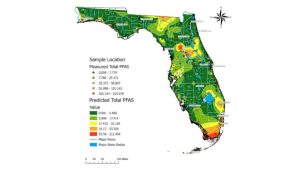
Figure 1. Map with measured total PFAS samples across a gradient of low concentrations (green dots) to medium concentrations (yellow dots) to higher concentrations (red dots). Shaded map colors are the predicted total PFAS using estimated values of PFAS concentrations from low (green) to high (red). Data, figure, and result interpolation from Sinkway et al. 2024.
A team of researchers completed a comprehensive statewide assessment of PFAS in Florida drinking water (Sinkway et al. 2024). The team collected 448 drinking water samples across all 67 Florida counties. The drinking water samples were analyzed for 31 PFAS, where 19 PFAS were found in at least one drinking water sample. The top five most frequently detected PFAS were 6:2 fluorotelomer sulfonate (6:2 FTS) (in 84% of the samples analyzed), Perfluorooctanoic acid (PFOA) (65%), linear perfluorooctane sulfonate (PFOS) (65%), branched PFOS (64%), and perfluorobutane sulfonic acid (PFBS).
A total of 107 taps had PFOA or PFOS concentrations above 4 ng/L (ppt), where the maximum total PFAS concentration in a tap was 219 ng/L (Click on link for higher resolution–Figure 1). The maximum contaminant level for PFOA and PFOS is 4 ng/L, legally enforced by the United States Environmental Protection Agency National Primary Drinking Water Regulation as of May 14, 2025 (USEPA, 2025). Overall, 8% of the drinking water samples analyzed exceeded 4 ng/L for PFOA and 16% for PFOS. The average total PFAS in city water was 15.6 ng/L, and in well water was 4.5 ng/L.

Table 1. Top average 12 Florida counties with highest and lowest total PFAS concentrations (ng/L). Data, figure, and result interpolation from Sinkway et al. 2024.
Okaloosa County had the 11th highest total PFAS (ng/L) concentration among the 67 Florida counties (Click on link for higher resolution–Table 1). Among the eight drinking water samples collected, the maximum PFAS concentration measured was 140 ng/L, and the lowest was 18 mg/L. Okaloosa County had one drinking water sample that exceeded the 4 ng/L standard for PFOA. There were no drinking water samples that exceeded 4 ng/L for PFOS.
Measured PFAS in Florida and Okaloosa County Surface Waters
A team of researchers completed a comprehensive statewide assessment of PFAS in Florida surface waters (Camacho et al. 2024). A network of citizen scientists collected 2,323 surface water samples across the 67 Florida counties. These surface water samples were analyzed for 50 PFAS, with 33 PFAS being detected in at least one surface water sample. The top five most frequently detected PFAS were perfluorooctanoic acid (PFOA) (94% of the samples), perfluorobutane sulfonic acid (PFBS) (65%), perfluorohexanoic acid (PFHxA) (61%), perfluorononanoic acid (PFNA) (54%), and perfluorooctane sulfonate (PFOS) (53%).
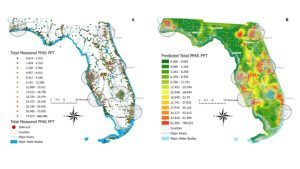
Figure 2. Map A contains all surface water sampled sites with detected PFAS, where the dots’ color represents the total PFAS concentration measured. Map B shows predicted PFAS levels based on measured total PFAS concentrations in surface water samples. Note that these values do not represent predicted PFAS concentrations on land. Data, figure, and result interpolation from Camacho et al. 2024.
There were 915 (39%) surface water samples with PFOA concentrations above 4 ng/L and 920 (40%) samples with PFOS above 4 ng/L (Click on link for higher resolution–Figure 2). All counties had at least one sample with PFOA, 96% had PFNA, 93% had PFBS, 91% had PFOS, and 82% of counties had PFHxA. The average PFAS detected among counties ranged from 2 ng/L of PFNA to 10 ng/L of PFOS. The maximum PFAS detected among counties ranged from 81 ng/L of PFOA to 1135 ng/L of PFOS. Figure 2
Okaloosa County ranked 27th among Florida counties due to 10 (20%) surface water samples with PFOA above 4 ng/L. Okaloosa County ranked 9th for the number of samples (38 total samples or 78% of the samples) above 4 ng/L for PFOS. A total of 49 surface water samples were collected in Okaloosa County. The average total PFAS concentration detected in a surface water sample was 31 ng/L, while the maximum total PFAS concentration detected in a sample was 185 ng/L.
Dr. Bowden, with the University of Florida’s College of Veterinary Medicine and Chemistry Department, led the PFAS research shared here. Dr. Bowden has extensive information on the Bowden Lab website (https://www.bowdenlaboratory.com/dr-bowden.html), including an interactive map of all the PFAS surface water samples collected in Florida. Select Okaloosa County under the filter section to see the surface water samples and learn more about the PFAS information for each sample collected in Okaloosa County (https://www.bowdenlaboratory.com/florida-surface-water.html).Figure 2 Table 1
What does this mean for Okaloosa County?
PFAS have been detected in drinking water and surface waters in Okaloosa County. Although not the highest concentrations or most frequent identified in Florida, there were drinking and surface water samples above USEPA’s 4 ng/L contaminant level standard. Understanding what PFAS are and joining in educational conversations about PFAS helps our community. Efforts that support continued sampling and extended monitoring also increase our understanding of PFAS concentrations in Okaloosa County’s drinking and surface waters. If you want to learn more about PFAS or join community scientists’ efforts to expand PFAS water monitoring, please contact Dana Stephens at the UF/IFAS Okaloosa County Extension Office.
References
Camacho, C.G., et al. 2024. Statewide surveillance and mapping of PFAS in Florida surface waters. American Chemical Society, 4: 434-4355. https://doi.org/10.1021/acsestwater
United States Environmental Protection Agency (USEPA). 2025. Per- and polyfluoroalkyl substances (PFAS) final PFAS national primary drinking water regulation. https://www.epa.gov/sdwa/and-polyfluoroalkyl-substances-pfas
McMahon, P.B., Tokranov, A.K., and Bexfield, L.M. 2022. Perfluoroalkyl and polyfluoroalkyl substances in groundwater used as a source of drinking water in the Eastern United States. Environmental Science and Technology 56(4): 2279-2288. https://doi.org/10.1021/acs.est.1c04795
Skinkway, T.D., et al. 2024. Crowdsourcing citizens for statewide mapping of per- and polyfluoroalkyl substances (PFAS) in Florida drinking water. Science of the Total Environment, 926: 1-9. https://doi.org/10.1016/j.scitotenv.2024.171932

by Laura Tiu | Jun 6, 2025
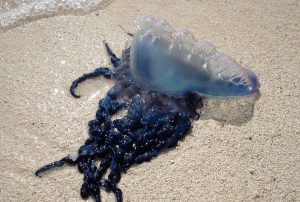
The colonial Portuguese man-of-war.
Photo: NOAA
I love summer; going to the beach, snorkeling, kayaking and grilling in the backyard. But summer comes with its own share of challenges. One of my least favorite summer guests is bugs. The list of bugs I dislike is long, but I’d like to focus on a few that like to torment us all.
Mosquitos are one of summer’s bad actors. Mosquito lay their eggs and their larvae mature in both manmade and natural water-holding containers such as bird baths, plants, bucket, used tire and holes in trees. Some mosquitos just bite while others carry disease. The easiest way to get rid of mosquitos is to get rid of any water-holding containers in the area.
Ants, in particular fire ants, are another unwelcome summer arrival. This invasive species is aggressive, and their painful stings can injure both humans and animals. Fire ant nests look like large mounds of dirt and typically have multiple openings. You must kill the queen to completely eliminate a colony. Even if the queen is killed, surviving ants may inhabit the mound or make a new mound until they die off. Some treatments that may work to get rid of these pests include baits, pesticides and boiling water.
Many biting flies, yellow flies are my least favorite, persistently attack man and animals to obtain a blood meal. Like mosquitoes, it is the female fly that is responsible for inflicting a bite. These biting flies like shady areas under bushes and trees and wait for their victim to pass by. They typically attack during daylight hours, a few hours after sunrise and two hours before sunset. Currently there are no adequate means for managing populations. Traps are sometimes effective in small areas such as yards, camping sites, and swimming pools.
In the water, jellyfish are the most common summer pest. While not bugs, their reputation for stinging people puts them in a similar category with the above-mentioned pests. Sea lice, actually the larval form of the thimble jellyfish, is a common near shore pest, while Portuguese Man-O-War and the box jellyfish can give a very painful sting. Another type, comb jellies, are not true jellyfish and do not sting. I you get stung, rinse the sting site with large amounts of household vinegar, or jelly-fish-free ocean water, for at least 30 seconds. Do not rub sand or apply any pressure to the area or scrape the sting site.
The University of Florida – IFAS has several good publications with information about these pests and more detail on how to manage them. Check out these publications if you, like me, have had your fill of summer pests.
Florida Container Mosquitos: https://edis.ifas.ufl.edu/publication/IN1315
Ant Control – https://sfyl.ifas.ufl.edu/lawn-and-garden/sustainable-fire-ant-control/
Yellow Flies – https://edis.ifas.ufl.edu/publication/IN595
Jellyfish – http://nwdistrict.ifas.ufl.edu/nat/tag/jellyfish/
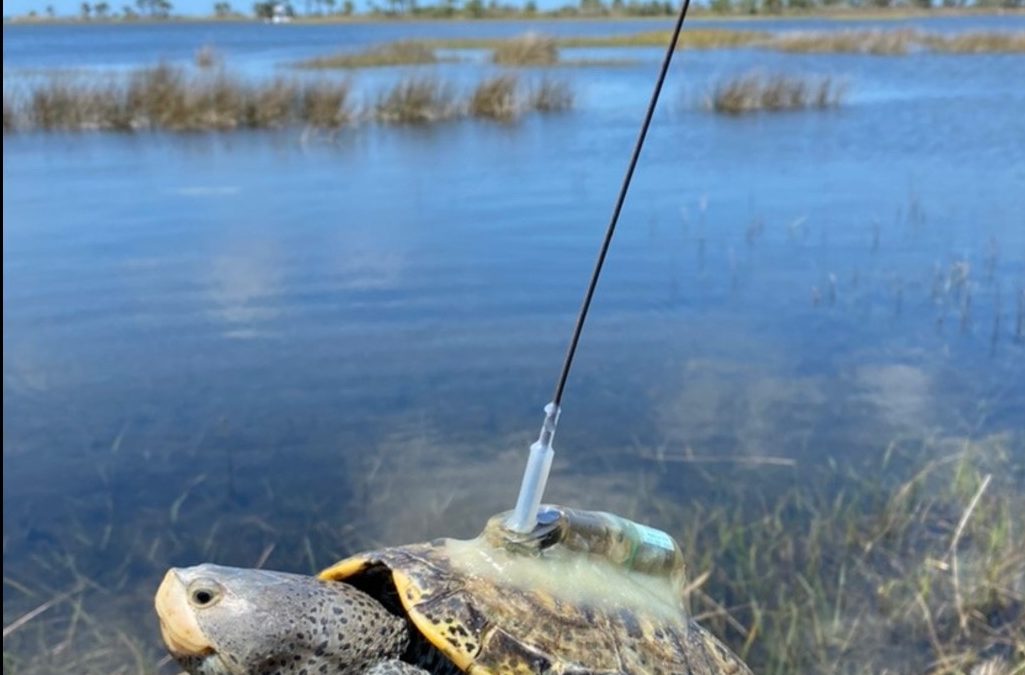
by Rick O'Connor | May 12, 2025
When I began working with terrapins 20 years ago, very few people in the Florida panhandle knew what they were – unless they had moved here from the Mid-Atlantic states. Since we initiated the Panhandle Terrapin Project in 2005 many more now have heard of this brackish water turtle.
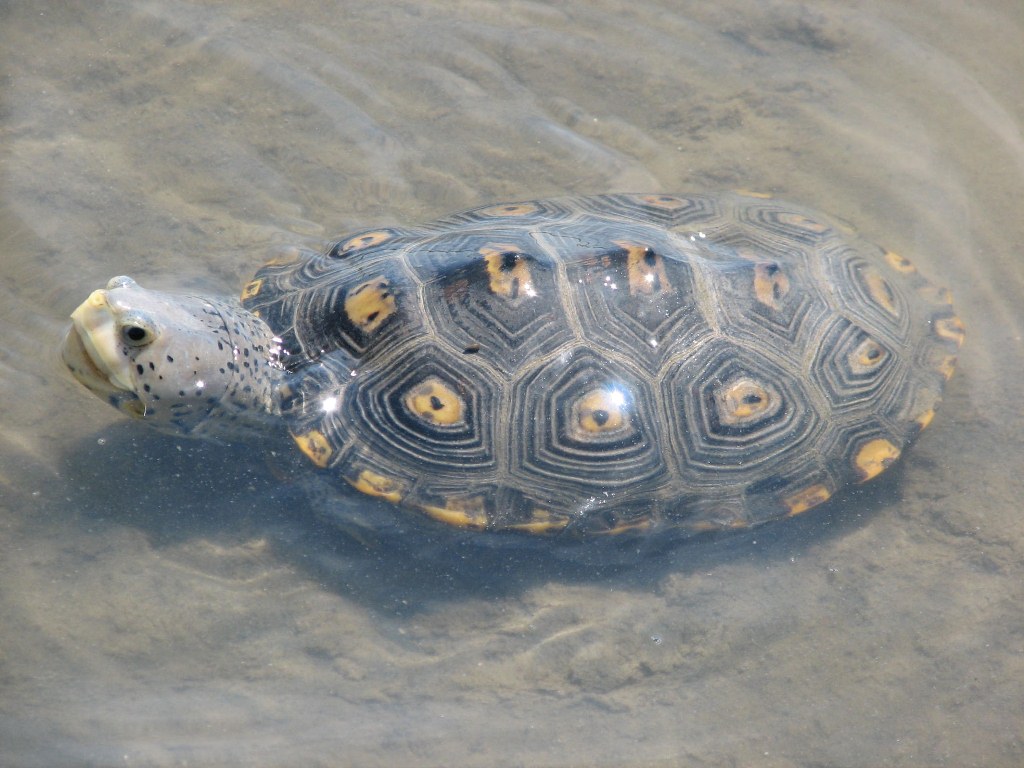
Ornate Diamondback Terrapin (photo: Dr. John Himes)
Diamondback terrapins are relatively small (10 inch) turtles that inhabit brackish environments such as salt marshes along our bays, bayous, and lagoons. They have light colored skin, often white, and raised concentric rings on the scales of their shells which give them a “diamond-backed” appearance. Some of them have dark shells, others will have orange spots on their shells.
The first objective for the project was to determine whether terrapins existed here, there was no scientific literature that suggested they did. We found our first terrapin in 2007, and this was in Santa Rosa County. We have since had at least one verified record in every panhandle county – diamondback terrapins do exist here.
The second objective was to locate their nesting beaches. Terrapins live in coastal wetlands but need high-dry sandy beaches to lay their eggs. Volunteers began searching for such and have been able to locate nesting beaches in Escambia, Santa Rosa, Okaloosa, Bay, and Gulf counties. We continue to search in the other counties, and for additional ones in the counties mentioned above. Once a nesting beach has been identified, volunteers conduct weekly nesting surveys, providing data which can help calculate the relative abundance of terrapins in the area.

Tracks of a diamondback terrapin.
Photo: Terry Taylor
The third objective is to tag captured terrapins to determine their population, where they move and how they use habitat. We initially captured terrapins using modified traps and marking them using a file notching system. We then partnered with a research team from the U.S. Geological Survey and now include passive integrated transponder tags (PIT tags) that help identify individuals, satellite tags that can be detected from satellites and track their movements, and recently acoustic tags which can also track movement.
The fourth objective is to collect tissue samples for genetic studies. This information will be used to help determine which subspecies of terrapins are living in the Florida panhandle.
As we move into the summer season, more people will be recreating in our bays and coastal waterways. If you happen to see a terrapin, or maybe small turtle tracks on the beach, we would like you to contact us and let us know. You can contact me at roc1@ufl.edu. Terrapins are protected in Florida and Alabama, so you are not allowed to keep them. If you are interested in joining our volunteer team, contact me at the email address provided.

by Dana Stephens | Apr 11, 2025
Okaloosa Waterwatch is an opportunity to explore water quality data in selected locations spanning the Okaloosa County portion of the Choctawhatchee Bay.
A site is selected each month, and available water quality data are summarized and explained. The purpose is to understand water quality and the condition of our waters. Thanks to the Choctawhatchee Basin Alliance (CBA), water quality data has been collected frequently (monthly) for many years.
Below are the February and March Okaloosa Waterwatch water quality summaries. February highlights the mid-bay bridge (Niceville) location, and March highlights the entrance to Rocky Bayou (Niceville) location.
Check out the Okalooas Waterwatch YouTube channel for a personalized audio review of the water quality summaries. The YouTube channel is Okaloosa Waterwatch (@OkaloosaWaterwatch) or navigate directly using this link: https://www.youtube.com/channel/UCGPVMsyMiTU5BT9xyrFhuYQ
Please contact Dana Stephens, UF/IFAS Okaloosa County Sea Grant Extension Agent, for more information or to learn more about water quality in Okaloosa County. Email is dlbigham@ufl.edu and office phone is 850-689-5850.
Okaloosa Waterwatch February 2025 (PDF Link)
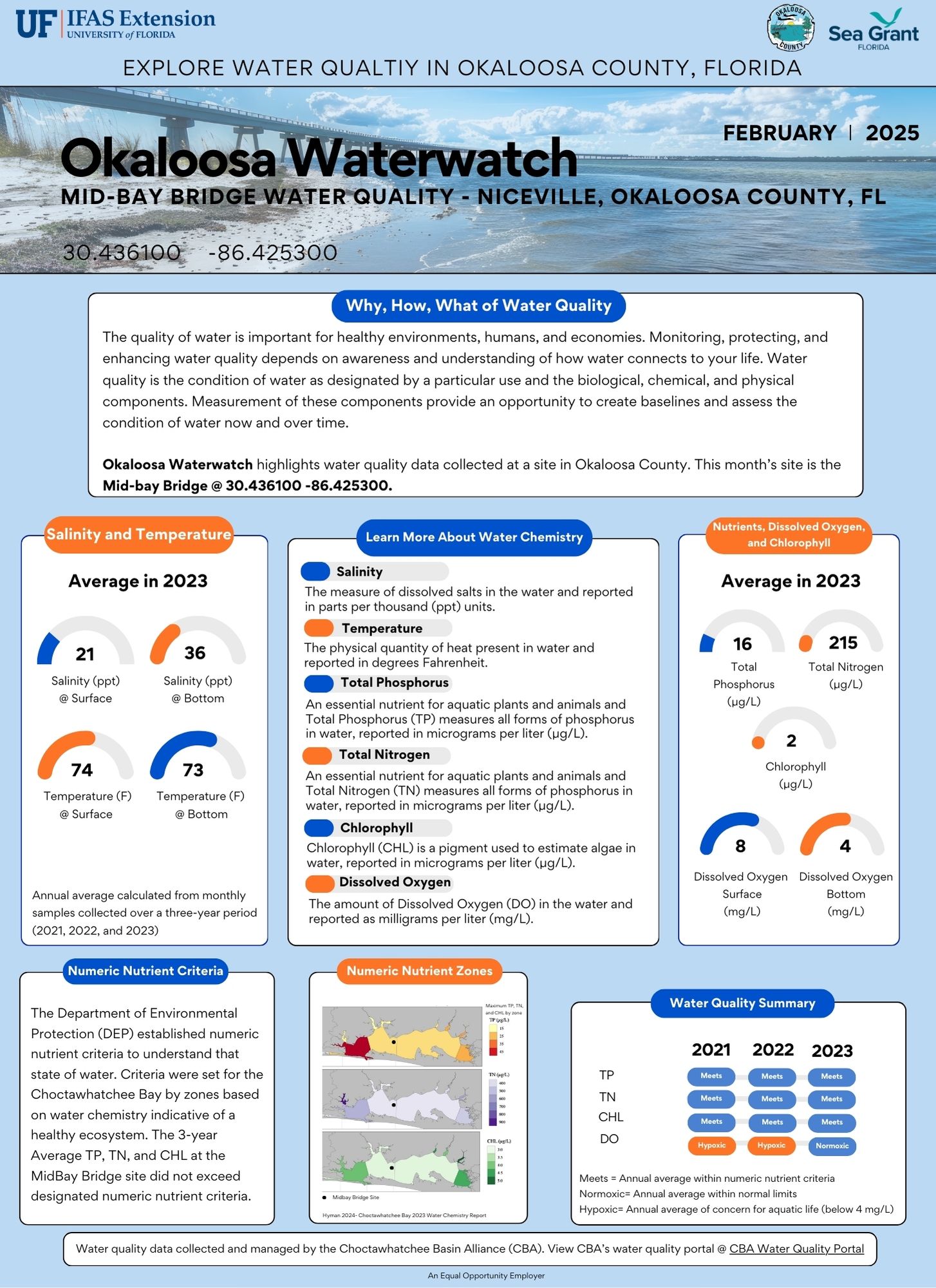
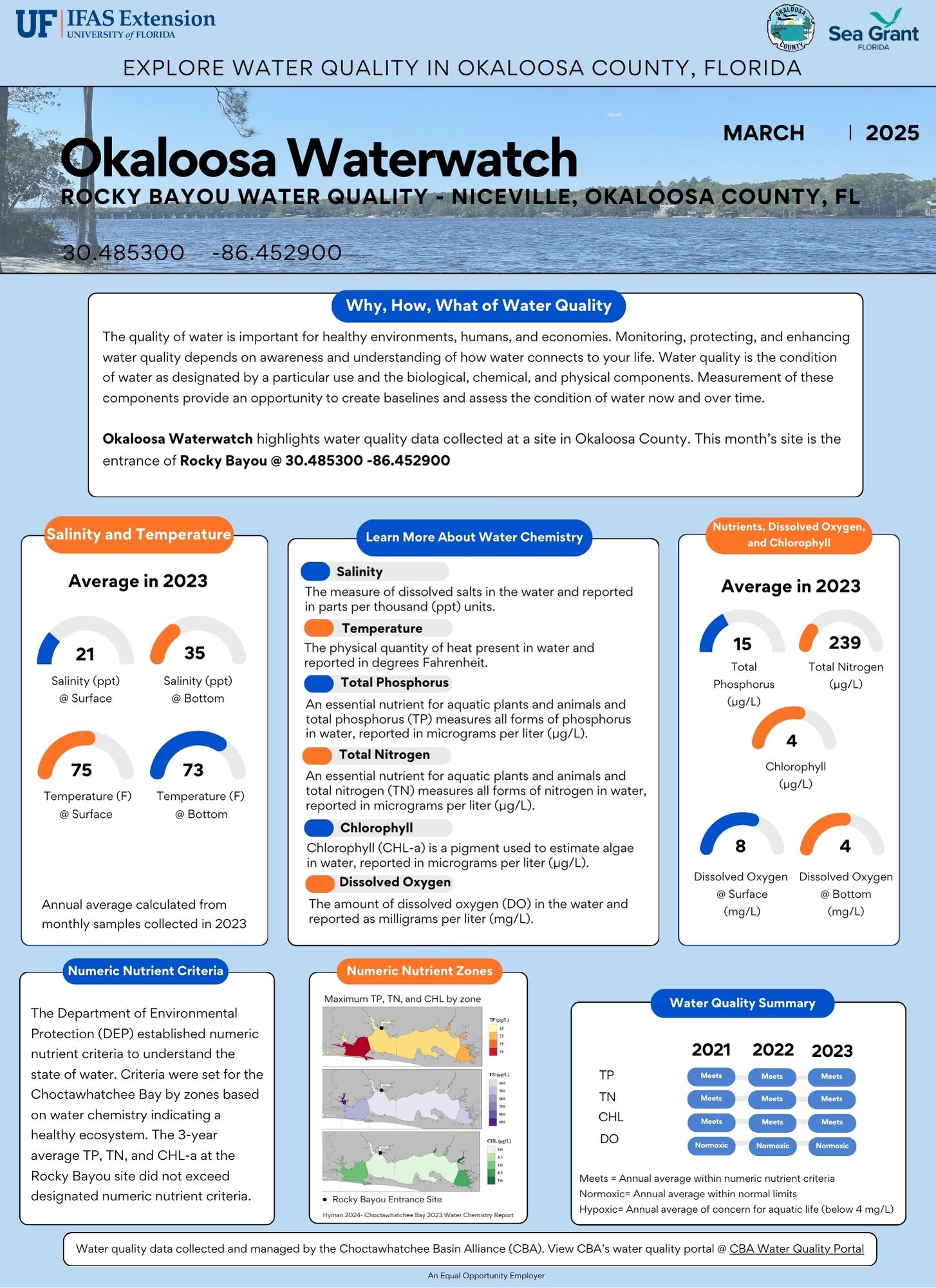
Okaloosa Waterwatch March 2025 (PDF Link)




















